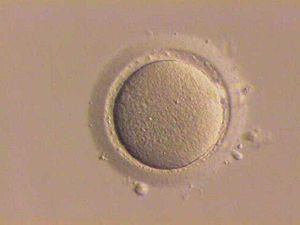
Hoffman Modulation Contrast
Encyclopedia

An example of the use of HMC illumination is in in-vitro fertilisation, where under brightfield illumination the near-transparent oocyte is hard to see clearly.
HMC systems typically consist of a condenser with a slit aperture, an objective
Objective (optics)
In an optical instrument, the objective is the optical element that gathers light from the object being observed and focuses the light rays to produce a real image. Objectives can be single lenses or mirrors, or combinations of several optical elements. They are used in microscopes, telescopes,...
with a slit aperture, and a polariser which is fitted between the condenser and the illumination source and is used to control the degree of contrast. The principle of HMC is used by a number of microscope manufacturers who have introduced their own variants of the technique, for example, Nikon advanced modulation contrast (NAMC), Olympus relief contrast (RC) and Leica's integrated hoffman modulation contrast (IMC).

